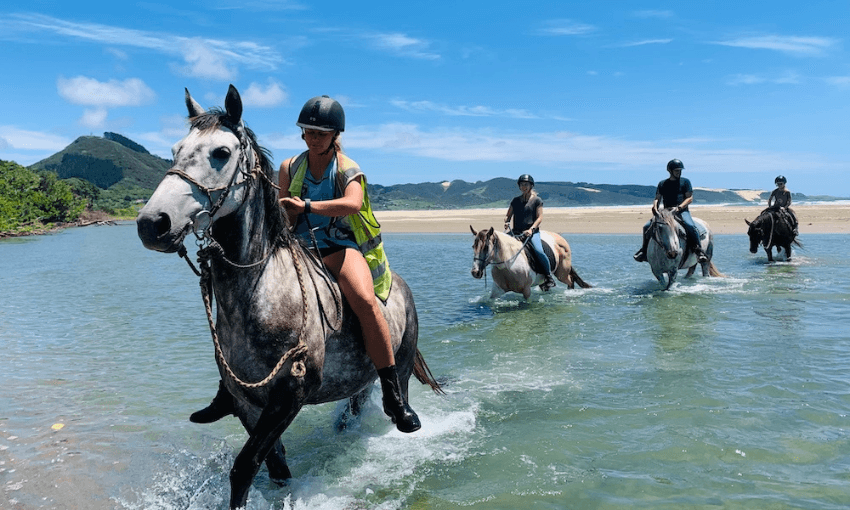Selena Anderson from Ahipara Horse Treks seems to have a perfect job. But what’s it like behind the scenes?
Standing on my dad’s deck on the beachfront of Te-Oneroa-a-Tōhē (Ninety Mile Beach), I’m greeted by a majestic scene. A solemn string of horses treks in unison along the sand, backlit by the descending sun. The riders are bareback, serene. The procession loops from the ocean’s edge to the estuary in front of my dad’s house, the water surface lightly rippling with the pounding of hooves.
I should move here, I think, the least equine a person can be. Become a horseriding instructor.
Selena Anderson, on the other hand, is the most equine a person can be. She runs Ahipara Horse Treks and teaches horseback riding as a full-time job. What is her life like? I wonder during the short car ride up the road to interview her. It must be… perfect?
“Having horses is tough,” Anderson says when I arrive at the trek’s home base on Foreshore Road in Ahipara. We’re surrounded by chatty children and sedate ponies munching grass. “It’s hard in winter – you’re out there still feeding in the rain and the mud. The animal always comes first.”
My image of the dream life barely dented, I push her to frontload more cons. “There’s always obstacles with horses,” she continues. “One might get injured – there’s always something.” She contends with strict health and safety regulations, eye-watering vet bills, and customers with dangerously inflated ideas about their own riding skills.
Then the kicker: “There’s no money in horses,” Anderson says with a wry smile. “You won’t get rich off it.”
Money or not, Anderson’s career was practically preordained. As a budding entrepreneur growing up on Waiheke Island, she offered pony rides along the beach in exchange for fish-and-chip money. She attended an equestrian academy during her final two years of high school before teaching and riding in the US for three months, then met her partner on a horse trek across Aotearoa.
Since 2019, she’s lived with him in Ahipara, running beach treks and teaching people – mostly kids, up to 30 a week – how to ride.
Most of the kids start as absolute beginners and Anderson has them riding bareback and jumping within a couple of years. Her youngest pupil is five. The horses have to be bombproof, Anderson says: on the beach they contend with parents pushing prams, dogs off leads, kites, Blokarts, and in the greatest nerve test of all, motorcyclists “showing off” by doing doughnuts around the horses.
The unflappable nature of Anderson’s 29 horses is even more remarkable considering most of them are wild animals she’s broken in herself. The secret? “Time,” Anderson says, “and getting them used to everything.”
I ask about the best part of the job. I’m imagining my own answer already: the seaside scenes, the serenity, the wholesale escape from the rat race. No boss, no Auckland drivers, no passive-aggressive email sign-offs.
“Horses,” she replies.
I’m surprised when Anderson tells me she occasionally pines for a life like mine. “Sometimes when it’s super hot or crappy weather,” she says, “I wish I had an office job.”
Ahhhhh, the old “grass is greener” trick. It gets us every time. After 20 minutes of chatting with Anderson, ponies nickering around us, I know she wouldn’t last a day in an office. It’s clear her fleeting fantasy about swapping horses for emails is as idle as my own reserve daydream. I couldn’t fit a bridle with a gun to my head.
I ponder the fickle nature of desire while Anderson chats about the Trek for Life, yet another equine activity she’s organising (Trek for Life is an annual week-long horse trek across remote New Zealand regions to raise money for first response and rescue services). When Anderson pauses, I ask what she does in her spare time. The answer hangs in the air for a split second, so obvious we both start giggling.
“Guess what,” she says, with cheerful irony. “I go horseriding.”



